Raw-Edge Fusible Applique
One of the easiest ways to applique is the raw-edge fusible-web method. Paper-backed fusible web individual pieces are fused to the wrong side of specified fabrics, cut out and then fused together in a motif or individually to a foundation fabric, where they are machine-stitched in place.
Choosing Applique Fabrics
Depending on the applique, you may want to consider using batiks. Batik is a much tighter weave, and because of the manufacturing process, it does not fray. If you are thinking about using quilting cottons, be sure to stitch your raw-edge appliques using a satin, blanket, straight or buttonhole stitch.
Cutting Applique Pieces
1. Fusible applique shapes should be reversed for this technique.
2. Trace the applique shapes onto the paper side of paper-backed fusible web. Leave at least 1/4" between shapes. Cut out the shapes, leaving a margin around the traced lines. Note: If doing several identical appliques, trace the reversed shapes onto the template material to make reusable templates for tracing shapes onto the fusible web. If you cannot see the lines on the back side of the paper when paper-piecing, draw over the lines with a small felt-tip marker. The lines should now be visible on the back side to help with the placement of the fabric pieces.
3. Follow the manufacturer's instructions to fuse the shapes to the wrong side of the fabric as indicated on the pattern for the color and number to cut.
4. Cut out the applique shapes on the traced lines. Remove the paper backing from the shapes.
5. Arrange and fuse the pieces to the quilt referring to the quilt pattern or fuse the shapes together on top of an applique ironing mat to make an applique motif that can then be fused to the quilt.
Stitching Applique Pieces
Machine-stitch applique edges to secure the appliqués in place and help finish the raw edges with matching or invisible thread (Photo 1). Note: To show stitching, all samples have been stitched with contrasting thread.
Invisible thread can be used to stitch appliques down when using blanket or straight stitches. Do not use it for satin stitch. Practice with invisible thread before using it on your quilt as it can sometimes be difficult to work with.
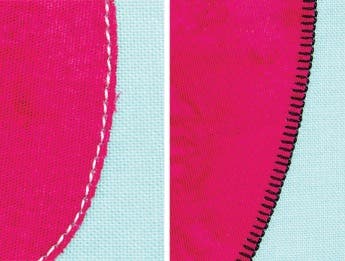

A short, narrow buttonhole or blanket stitch is most commonly used when stitching applique to a project. Your machine manual may also refer to this as an applique stitch. Be sure to stitch next to the applique edge with the stitch, catching the applique.
Practice turning inside and outside corners on scraps before stitching applique pieces. Learn how your machine stitches so that you can make the pivot points smooth.
1. To stitch outer corners, stitch to the edge of the corner and stop with the needle in the fabric at the corner point. Pivot to the next side and continue to sew (Photo 2). Depending on your shape, you may get a box on an outside corner.
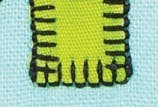

2. To stitch inner corners, pivot at the inner point with the needle in the fabric (Photo 3). You may see a Y shape form in the corner.
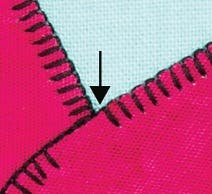

3. You can also use a machine straight stitch. Turn corners in the same manner, stitching to the corners and pivoting with the needle in the down position (Photo 4).
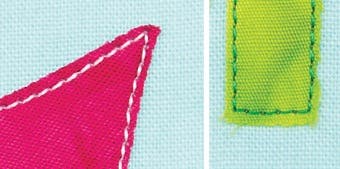

General Applique Tips
1. Depending on your fabric choice, use a light- to medium-weight stabilizer behind an applique to keep the fabric from puckering during machine stitching (Photo 5).
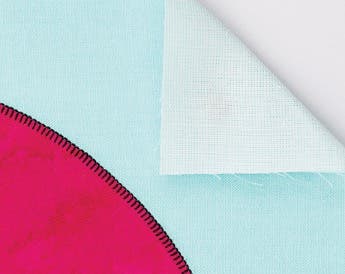

2. To reduce the stiffness of a finished applique, cut out the center of the fusible web shape, leaving 1/4" to 1/2" inside the pattern line. This gives a border of adhesive to fuse to the background and leaves the center soft and easy to quilt.
3. If an applique fabric is so light-colored or thin that the background fabric shows through, fuse a lightweight interfacing to the wrong side of the fabric. You can also fuse a piece of the applique fabric to a matching piece, wrong sides together, and then apply the fusible with a drawn pattern to one side.
